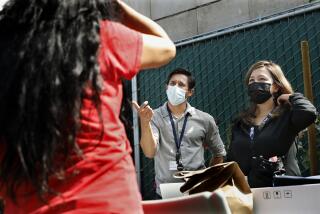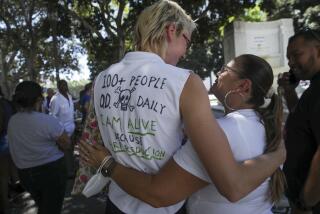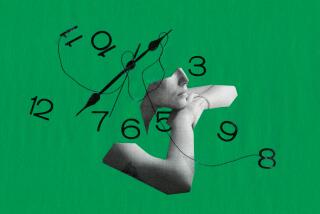N.Y. Uses Methadone as Way Off the Needle
- Share via
NEW YORK — In many ways, methadone is a lot like the drugs that it promised to replace: heroin and morphine.
A white, crystalline, synthetic opiate, methadone hydrochloride is similar in potency and effect to those naturally derived narcotics. If improperly taken, it, too, can be deadly.
Methadone was created by German chemists during World War II as a painkilling substitute for morphine. It was called dolophine in honor of Adolf Hitler. In the United States, however, methadone, as it later was renamed, came into its own during the mid-1960s as an effective tool in treating heroin addiction.
At New York City’s Rockefeller University, two U.S. physicians, Vincent Dole and Marie Nyswander, who were husband and wife, developed the technique of methadone maintenance to treat heroin addicts. The two researchers found that methadone was able to block the euphoric effects of heroin.
Unable to get high, addicts gave up heroin and instead depended on a daily dose of methadone mixed with Tang orange drink, which masked the drug’s bitter aftertaste. Under strict medical supervision, a small group of addicts was treated in experimental programs that stressed counseling, helping them to reduce their criminal behavior and regain productive lives.
The doctors’ remarkable findings excited government leaders, who were desperate for an effective weapon against heroin addiction. In his 1969 bid for reelection, New York Mayor John V. Lindsay promoted the use of methadone treatment as a way to reduce crime and other social ills caused by the city’s drug trade.
In the early 1970s, President Richard M. Nixon encouraged the use of methadone as part of his federal effort against drugs and crime. Many methadone clinics were opened under the aegis of the city’s Addiction Services Agency. During its fiscal crisis in the late 1970s, the city got out of the drug-treatment business. In an agreement with the city, New York state assumed the task of overseeing and largely paying for the city’s drug-treatment system.
Today, about 31,000 New York City methadone patients receive treatment at 95 clinics. More than 100,000 patients have passed through programs in New York, where methadone is used primarily for long-term therapy. Half of the city’s methadone patients have been in treatment for more than three years.
Although effective for many patients, methadone maintenance has not stopped the sweeping tide of heroin addiction in New York City. When methadone maintenance began in the mid-1960s, there were 60,000 heroin addicts in New York City; today there are more than 200,000.
After an initial physical exam to determine that they are heroin abusers, patients are prescribed daily doses of methadone, usually ranging from 40 milligrams to 80 milligrams. For a non-addict, such a dose could be lethal, experts say. All but 10% of the city’s clinics provide take-home doses to patients so the clinics can close on weekends.
Medicaid pays for about half of New York City’s $80-million-a-year methadone system, with state funding, private insurance and individual payments accounting for the rest. Most eligible patients obtain Medicaid cards from state and city agencies with the help of clinic staff. Recently, the state changed its Medicaid payments from a sliding daily rate to a flat $69 weekly payment for each patient.
About 70% of methadone treatment is provided by hospital-run programs while nonprofit clinics and private methadone doctors account for the rest.
Because of political opposition and a lack of funding, a new methadone clinic has not opened in New York City since the 1970s, state officials say.
Three programs in New York use a methadone-to-abstinence approach designed to wean patients of all drugs, including methadone. Methadone patients, like addicts receiving other forms of drug treatment, often relapsed into illegal drug-taking. In the early 1980s, a state study found that 75% of methadone patients had been in treatment before.
Medical texts say that methadone does not produce a euphoric high and lasts only 24 hours in a person’s system. But many patients say that methadone’s sensation lasts longer--two days or more. Experts say that other drugs used to treat heroin addicts have failed because patients don’t get the same sensation as they do with methadone.
“If you take enough methadone, you do get a buzz,” says Dr. Marvin Snyder, a research expert for the National Institute on Drug Abuse. “You can’t treat people if they don’t want to take the treatment. Methadone is successful because it makes them feel normal, and they do get a buzz.”
Thousands of patients have received help from methadone. But many of the 200,000 needle-using heroin addicts in New York City also inject cocaine. On the street, it’s called speed-balling. Unlike it has with heroin, methadone has no pharmacological blocking power with cocaine. Most of the estimated 300,000 addicts who regularly use crack and cocaine receive drug-free treatment or none at all.
Methadone, which is manufactured by two U.S. pharmaceutical firms, Eli Lilly and Roxane, costs relatively little--$25,000 to $50,000 a year for a 600-patient clinic. Most expenses come from staff salaries and benefits, other health services, rent and related expenses.
Treating a methadone patient on an outpatient basis costs $3,000 a year. Other treatments--such as drug-free therapy, which is usually at a residential facility and provides more counseling and support services than most methadone programs--cost about $15,000 a year. State officials estimate that only one of every five intravenous-drug addicts gets any treatment.
More to Read
Sign up for Essential California
The most important California stories and recommendations in your inbox every morning.
You may occasionally receive promotional content from the Los Angeles Times.










